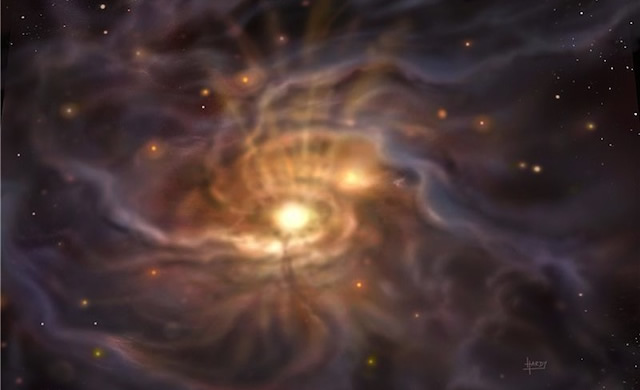
Gli scienziati hanno osservato in dettaglio, senza precedenti, la nascita di una stella massiccia all’interno di un nucleo di una nube oscura a circa 10.000 anni luce dalla Terra. Il team ha utilizzato il nuovo telescopio ALMA (Atacama Large Millimeter / submillimetrica Array) in Cile, il radiotelescopio più potente al mondo, per visualizzare il grembo stellare che ha 500 volte la massa del Sole ed è molto più luminoso: il più grande mai visto nella nostra galassia.
I ricercatori dicono che le loro osservazioni, che stanno per essere pubblicate sulla rivista Astronomy and Astrophysics, rivelano come la materia viene trascinata verso il centro della grande nube gassosa dall’attrazione gravitazionale della stella, o stelle, in formazione, lungo un numero di filamenti densi. “Le notevoli osservazioni effettuate tramite Alma ci hanno permesso di avere il primo vero sguardo in profondità verso ciò che stava accadendo all’interno di questa nube”, ha detto il Dott. Nicolas Peretto, dell’università di Cardiff. “Volevamo vedere come queste stelle gigantesche si formano e crescono, e certamente abbiamo raggiunto il nostro obiettivo. Una delle fonti che abbiamo trovato è un gigante assoluto, il più grande nucleo protostellare mai avvistato nella Via Lattea! “Anche se eravamo già convinti che la regione in questione era un buon candidato per essere considerata una enorme nube di formazione stellare, non ci aspettavamo di trovare una stella massiccia con embrione al suo centro.
Questa nuvola prevede la formazione di almeno una stella 100 volte più massiccia del Sole e fino ad un milione di volte più luminosa. Solo circa una su 10.000 di tutte le stelle della Via Lattea raggiungere quel tipo di massa”.
Esistono diverse teorie su come queste stelle massicce si formano, ma i risultati della squadra avvalora l’idea che l’intero nucleo della nube inizia a collassare verso l’interno, con materiale che piove in direzione del centro per formare una o più stelle massicce. Il co-autore dello studio, il professor Gary Fuller dell’Università di Manchester, ha detto: “Non solo queste stelle sono rare ma la loro nascita è estremamente rapida e dall’infanzia breve, in modo da rendere spettacolare la scoperta di un oggetto così massiccio e in fase così prematura nella sua evoluzione, all’interno della nostra Galassia. “Le nostre osservazioni rivelano fin nel minimo dettaglio la rete filamentosa di polvere e gas che scorre nella regione compatta centrale della nube e questo sostiene con forza la teoria del collasso globale per la formazione di stelle massicce.” L’Università di Manchester ospita il Science and Technology Facilities Council (STFC), il centro di supporto per gli astronomi del Regno Unito che utilizzano ALMA, in cui sono state elaborate le osservazioni.
Scientists have observed in unprecedented detail the birth of a massive star within a dark cloud core about 10,000 light years from Earth. The team used the new ALMA (Atacama Large Millimetre/submillimetre Array) telescope in Chile – the most powerful radio telescope in the world – to view the stellar womb which, at 500 times the mass of the Sun and many times more luminous, is the largest ever seen in our galaxy.
The researchers say their observations – to be published in the journal Astronomy and Astrophysics – reveal how matter is being dragged into the centre of the huge gaseous cloud by the gravitational pull of the forming star – or stars – along a number of dense threads or filaments. “The remarkable observations from ALMA allowed us to get the first really in-depth look at what was going on within this cloud,” said lead author Dr Nicolas Peretto, from Cardiff University. “We wanted to see how monster stars form and grow, and we certainly achieved our aim. One of the sources we have found is an absolute giant — the largest protostellar core ever spotted in the Milky Way! “Even though we already believed that the region was a good candidate for being a massive star-forming cloud, we were not expecting to find such a massive embryonic star at its centre.
This cloud is expected to form at least one star 100 times more massive than the Sun and up to a million times brighter. Only about one in 10,000 of all the stars in the Milky Way reach that kind of mass.”
Different theories exist as to how these massive stars form but the team’s findings lend weight to the idea that the entire cloud core begins to collapse inwards, with material raining in towards the centre to form one or more massive stars. Co-author Professor Gary Fuller, from The University of Manchester, said: “Not only are these stars rare, but their births are extremely rapid and childhood short, so finding such a massive object so early in its evolution in our Galaxy is a spectacular result. “Our observations reveal in superb detail the filamentary network of dust and gas flowing into the central compact region of the cloud and strongly support the theory of global collapse for the formation of massive stars.” The University of Manchester hosts the Science and Technology Facilities Council (STFC)-funded support centre for UK astronomers using ALMA, where the observations were processed.
Source/Continue reading → earthsky.org





















